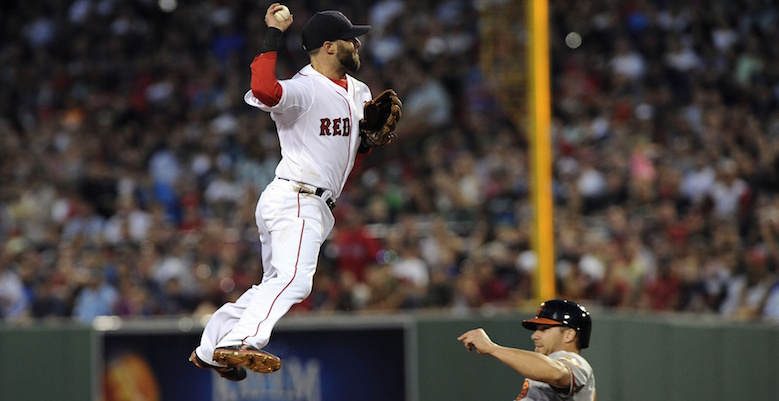Spring training is in full swing, and so are the storylines — Pablo Sandoval’s weight, the starting rotation and David Ortiz’s farewell tour, among others — we expected to come with it. One player we haven’t heard much of is Dustin Pedroia, arguably the second-most recognizable name in the organization. That’s nothing unusual. The second baseman has been a model for consistency and reliability throughout his career, and is hardly ever involved in controversy. He plays hard, fields well and, with a career .281 TAv, has been one of the better-hitting second baseman in the game over the last nine years.
That doesn’t mean there aren’t question marks surrounding Pedroia this season. He’s coming off a second-straight year marred by injuries, and has seen a drop in production to go with it. He followed up a career-worst .268 TAv in 2014 with a not-much-better .271 mark. And although his .150 ISO last year was a dramatic improvement from his 2013 (.114) and 2014 (.098) marks, his power isn’t what it was from 2008-12. His 1.87 BWARP was good for 19th among second basemen. The decline is real, folks.
What does that mean for this season? Will Pedroia take another step backward at 32 years old? Has he finally slipped into mediocrity?
If PECOTA is any indication, maybe things aren’t as bad as they seem. Pedroia is projected to finish 2016 with a 3.6 WARP, .274 TAv and a .288/.354/.417 slash line at a position that isn’t exactly loaded with elite offensive players. Sure, those numbers probably mean he’s not a top-of-the-order guy anymore. And in a different era those projected numbers would be quite average for a starting position player. But it may still place Pedroia in the upper echelon of major-league second basemen.
Pedroia finished with the 13th-best TAv among second basemen with at least 300 plate appearances last season. This season he’s projected to finish with a better mark than 10 of the 12 players ahead of them — Robinson Cano and Ben Zobrist are projected to have TAvs of .298 and .278, respectively — and a better WARP than nine of them. That means he should be just as good, if not better, than the likes of Jose Altuve, Dee Gordon, Jason Kipnis and Roughned Odor. The Red Sox would likely rather have some of those players for the long run. But for 2016, Pedroia is still their best bet.
Pedroia has taken multiple trips to the disabled list and missed 136 games over the past two seasons. And when he wasn’t missing time, he was typically playing in pain.
Those, of course, are just projections. PECOTA can’t directly account for injuries, and Pedroia has had plenty of those. He’s taken multiple trips to the disabled list and missed 136 games over the past two seasons. And when he wasn’t missing time, he was typically playing in pain. Health being a factor in 2016 can’t be ruled out.
Then there’s the natural, and often unpredictable, decline that comes with age. Pedroia is 32 years old and has already experienced notable dips in performance over the last two seasons. But 32 doesn’t have to mark the beginning of the end. There have been many second basemen who have continued to play well at 32 over the past few decades. Dan Uggla, for example, posted a .272 TAv and 4.0 WARP at 32 in 2012, an improvement from the year before. Those numbers are comparable to Pedroia’s 2016 projections, and certainly attainable. For what it’s worth, Uggla has played in about 100 more career games than Pedroia, and Pedroia has a higher career TAv and WARP.
Willie Randolph, many Yankees fans would argue, is one of the greatest players not in the Hall of Fame. The second baseman finished with a career .274 TAv and 51.8 WARP over 17 seasons. He sported a 38.9 WARP with two more seasons than Pedroia under his belt entering his age 32 season in 1987. The overall picture is one similar to Pedroia, who has a career 29.6 WARP.
Randolph had TAvs of .270, .271, .271 and .276 between 1983-86 and a combined 13 WARP. His age 32 season in which he posted a .289 TAv and 3.7 WARP trumped all of those. So yes, there is reason to believe Pedroia can be better this season than he was in either of the last two.
Pedroia’s outlook is not as bad as it seems. He may be trending downward as he moves further from 30, but it doesn’t mean he won’t be one of the Sox’s most valuable players. Barring injury, he should remain one of the better second basemen in baseball. Father Time can’t take that away just yet.
Pedroia has been a spring training afterthought thus far, and that’s ok. Health is a concern, but two relatively down years at the plate and growing age don’t have to be yet. The projections are realistic for Pedroia. And if he meets those, that should be more than enough.
Photo by Bob DeChiara/USA Today Sports Images
